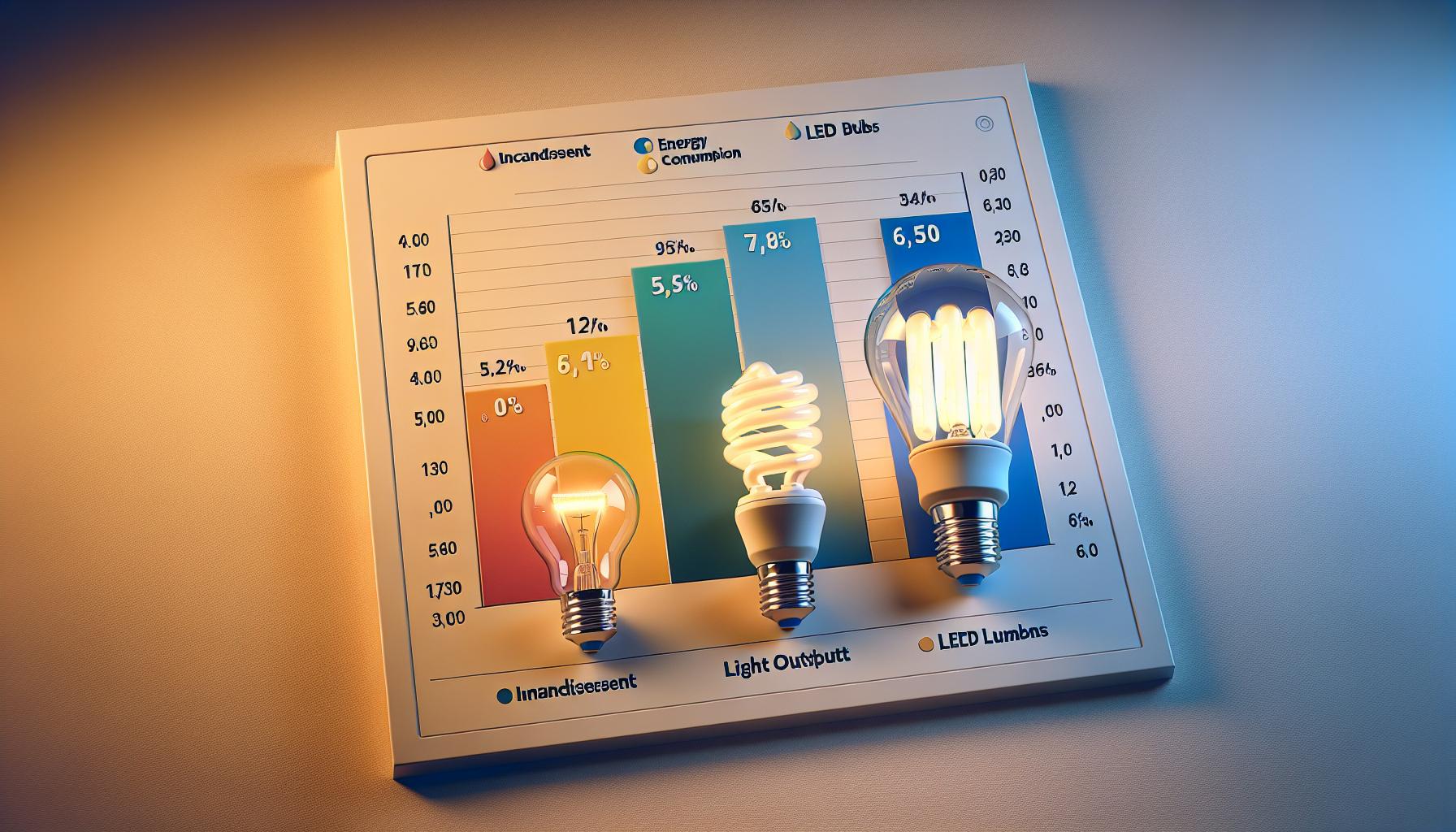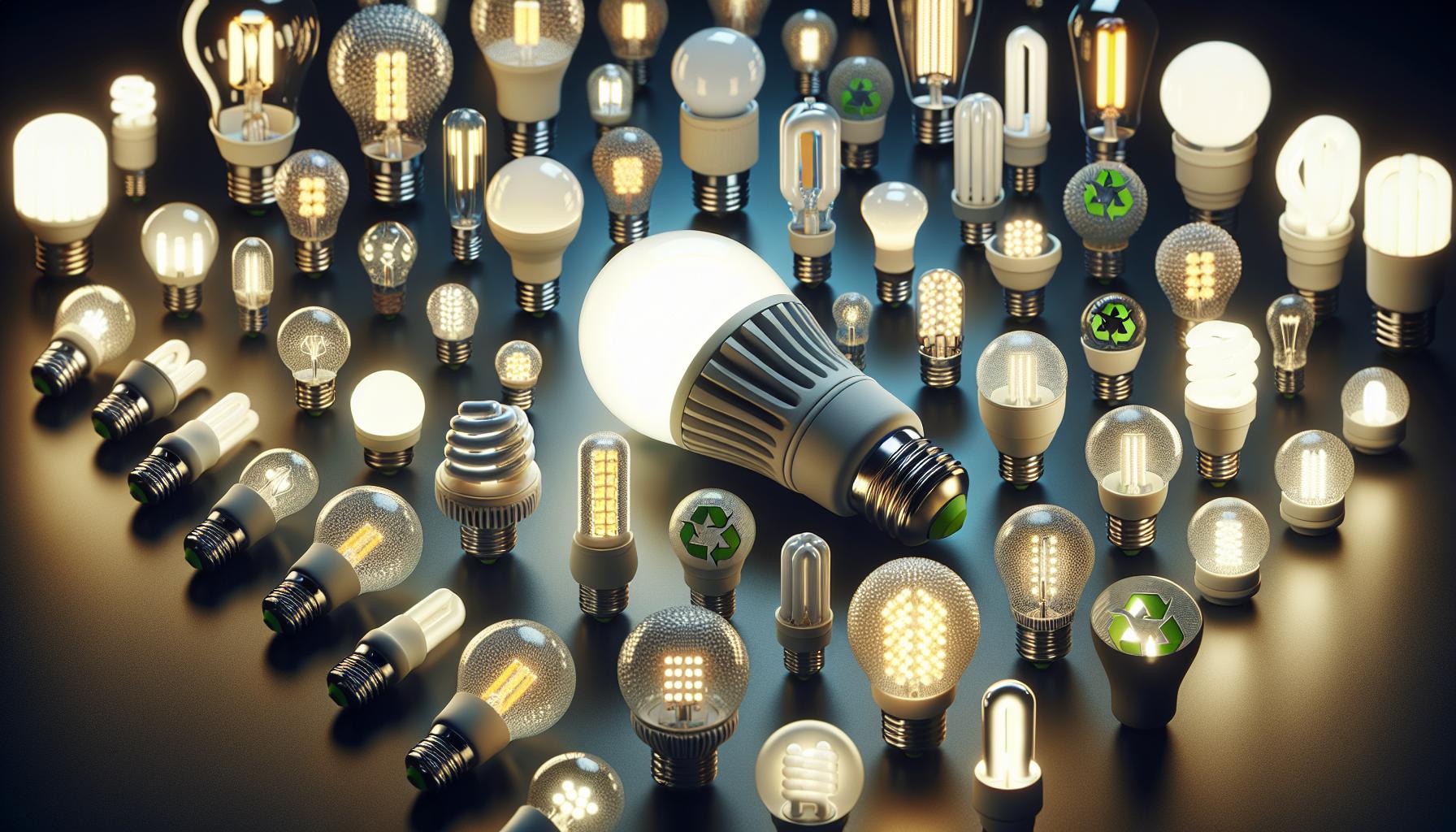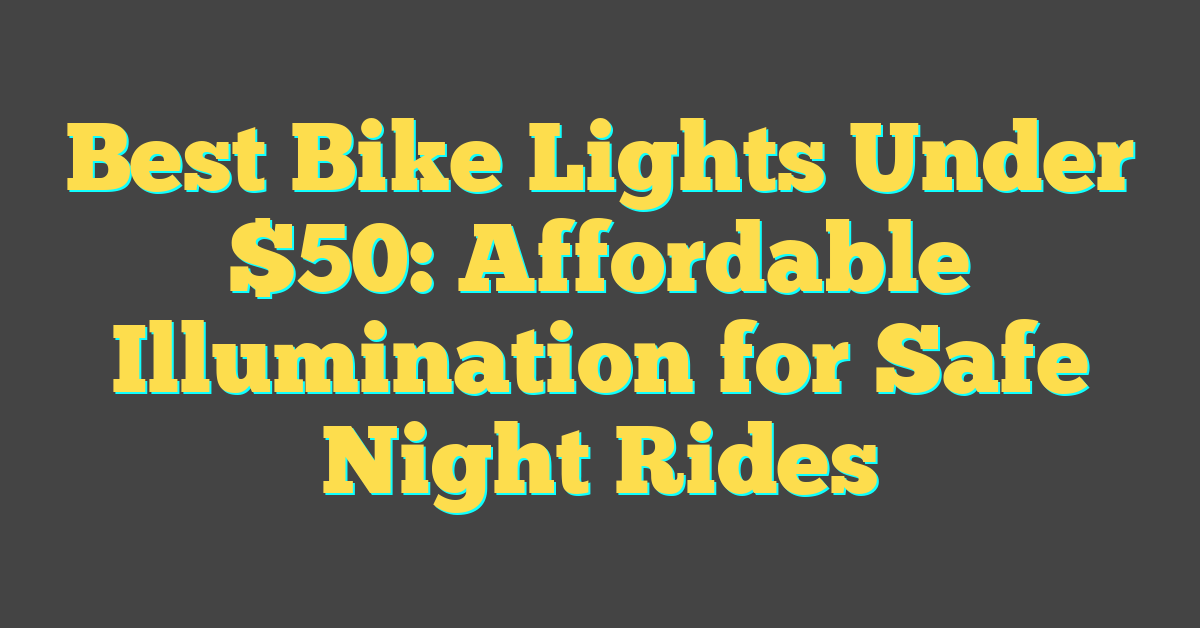Ever wondered why your energy bill ticks up every time you flip the switch? It’s time to shine a light on the most energy-efficient bulbs that’ll keep your home bright and your bills low. You’re not just choosing a bulb; you’re picking a side in the battle against rising energy costs.

Why energy efficiency matters?
When you’re knee-deep in your latest home DIY project or pondering over the perfect lighting setup, it’s easy to overlook the efficiency aspect of the bulbs you choose. Yet, energy efficiency plays a pivotal role, not just in curbing your monthly bills but in fostering a sustainable environment as well.
Firstly, energy-efficient bulbs consume less power which means they are kind to your wallet. The Department of Energy asserts that switching to energy-efficient lighting is one of the fastest ways to cut your energy bill. By replacing your home’s five most frequently used light fixtures or bulbs with models that have earned the ENERGY STAR, you can save $45 per year on average.
Moreover, energy efficiency helps in reducing the demand on power plants and the subsequent release of greenhouse gases. With the heightened concern for climate change, opting for eco-friendly bulbs reduces the carbon footprint of your home, making your DIY endeavors not just creative, but also environmentally responsible.
| Bulb Type | Average Lifespan (hours) | Energy Use (Watts) |
|---|---|---|
| Incandescent | 1,000 | 60 |
| Halogen | 1,000 to 3,000 | 42 |
| CFL | 8,000 to 10,000 | 14 |
| LED | 15,000 to 25,000 | 10 |
Switching to LEDs or CFLs from traditional incandescent bulbs can save a substantial amount of energy. For instance, LEDs use about 75% less energy than incandescent lighting. Not to mention, they offer a longer lifespan which means you’re not climbing up that ladder to replace bulbs as often.
Remember, each energy-efficient bulb installation is a step towards a more sustainable future. It’s where your passion for lighting and home projects aligns perfectly with the movement towards green living. As you continue to illuminate your space, consider the broader impact of your choices, ensuring each light bulb reflects both your personal style and a commitment to energy conservation.
Understanding lumens, watts, and energy efficiency

When diving into the world of energy-efficient lighting, you’ll often hear the terms lumens and watts thrown around. Lumens measure the amount of light produced by a bulb, essentially telling you how brightly it’ll shine. Think of lumens as the output of visibility your eyes will thank you for. Watts, on the other hand, refer to the energy consumed by the light bulb to produce those lumens.
Traditionally, you might’ve reached for a 60-watt incandescent bulb. However, here’s where energy efficiency becomes the star of the show. An LED bulb, for instance, can give you the same brightness for a mere fraction of the wattage. Let’s lay down the facts:
| Bulb Type | Incandescent | CFL | LED |
|---|---|---|---|
| Brightness | 800 lumens | 800 lumens | 800 lumens |
| Power Consumption | 60 watts | 14 watts | 8-12 watts |
As you can see, LED bulbs are champions when it comes to using less power for the same amount of light. It’s like hitting two birds with one stone – you’re saving on your bill and doing Mother Earth a solid.
To truly elevate your energy-efficiency game, keeping an eye on the lumens-to-watts ratio is key. The higher this ratio, the more bang for your buck you’re getting in terms of illumination versus energy used. LEDs typically outshine their counterparts with a higher lumens-per-watt ratio. And that’s great for both your wallet and the environment.
Moreover, consider the lifespan of different bulbs. LED lights don’t just save energy, they also boast longer lifespans, which means less frequent replacements and more money saved. Your DIY projects and home upgrades will shine brighter for longer with a trusty LED by your side.
Don’t forget to look for the ENERGY STAR certification when shopping for bulbs. This seal of approval means you’re getting a product that meets strict energy efficiency guidelines set by the EPA. So, when you see that label, you know you’re choosing wisely for energy conservation.
Remember, every watt you save with a switch to more efficient bulbs adds up to a brighter future for the planet. Keep this in mind as you light up your living spaces and embark on your next illuminating project.
Comparing common light bulb types

« What Does Light Bulb Do? Unlock a World of Benefits for Your Home
Do LED Light Bulbs Make Noise? Uncover the Silent Truth »
When you’re knee-deep in a DIY home project, the right lighting can make all the difference. Let’s break down the pros and cons of the most common light bulb types on the market—LEDs, incandescent bulbs, compact fluorescent lamps (CFLs), and halogen bulbs.
LED (Light Emitting Diodes) are the standout choice for energy efficiency and lifespan. They consume up to 90% less energy than traditional incandescent bulbs and can last for up to 25,000 hours. They’re your go-to for both ambient and task lighting and they turn on instantly to full brightness.
Incandescent bulbs, the old standard, are much less energy-efficient. Their filament design means more energy is wasted as heat, which is why they typically last only about 1,200 hours. They’re phasing out but might still be useful for a warm and cozy ambiance in rooms you don’t frequent often.
CFLs are a middle ground, using about 70% less energy than incandescents and lasting around 8,000 hours. Just remember, they need a little warm-up time to reach full brightness, so they might not be the best for areas where you need immediate light.
Halogen bulbs are incandescent’s energy-efficient cousins, using about 20-30% less energy and having a life span that’s a tad longer—around 2,000 to 4,000 hours. They shine bright with their intense, white light, which is great for workspaces or for highlighting specific areas.
Here’s a quick snapshot:
| Bulb Type | Energy Savings | Lifespan | Warm-up Time |
|---|---|---|---|
| LED | Up to 90% | ~25,000 hrs | Instant |
| Incandescent | None | ~1,200 hrs | Instant |
| CFL | ~70% | ~8,000 hrs | Slow |
| Halogen | 20-30% | ~2,000 hrs | Instant |
The benefits of LED lights for energy efficiency

As you continue on your quest to illuminate your living spaces effectively while saving on those electricity bills, you can’t ignore the impressive edge that LED (Light Emitting Diode) technology offers. Years of innovation have positioned LEDs as the frontrunners in the race for energy-efficient lighting.
Let’s dig into why you, as a lover of both home DIY projects and savvy lighting solutions, will find LEDs irresistible. First up is their remarkable energy efficiency. Unlike traditional bulbs that squander a lot of their energy as heat, LEDs direct most of their energy toward producing light—they use about 75% less energy than incandescent lighting. It’s not just about lower power consumption; it’s also the unparalleled longevity they boast. An LED bulb can last up to 25 times longer than its incandescent counterparts.
As a DIYer, you’ll appreciate the versatility of LEDs—they come in a spectrum of colors, dimmable options, and various shapes and sizes. This flexibility means that whether you’re setting up a cozy reading nook or overhauling your kitchen lighting, LEDs can adapt to your project’s demands.
While other bulbs might take a moment to warm up to their full brightness, LEDs shine bright instantaneously. This instant-on feature combines with their low heat output to make them a standout choice for a variety of applications, especially in places where safety is paramount.
It’s not just about individual savings or convenience; choosing LEDs contributes to a larger movement towards sustainability. With an eye on reducing your carbon footprint, LED bulbs are a choice that you can feel good about. They don’t contain mercury like CFLs and boast a longer life, which means they contribute less to landfill waste.
For a detailed comparison, here’s a quick look at the key numbers that might interest you:
| Feature | LED | Incandescent |
|---|---|---|
| Energy Usage | 75% less | – |
| Lifespan | Up to 25x longer | – |
| Warm-up Time | Instantly Bright | Takes Time |
| Safety | Low Heat Output | High Heat Output |
Are CFL bulbs still an energy-efficient option?

Compact Fluorescent Lamps, or CFL bulbs, have been a staple in energy-efficient lighting for years. Though not as advanced as LED bulbs, they still have a place in the eco-friendly lighting conversation. You might remember them as the spiral-shaped bulbs that took a while to get bright. Despite the rise of LEDs, CFLs can still be seen as a middle ground between incandescent and LED bulbs in terms of energy efficiency and cost.
CFL bulbs typically use about 70-75% less energy than traditional incandescent bulbs and can last up to 10 times longer. Not quite up to par with LEDs but certainly a step up from the old-school incandescents, right? Here’s a brief rundown on their efficiency:
| Feature | Incandescent Bulbs | CFL Bulbs | LED Bulbs |
|---|---|---|---|
| Energy Usage | High | Moderate | Low |
| Lifespan | Short | Longer | Longest |
| Warm-Up Time | Instant | Slow | Instant |
| Cost | Low | Moderate | Higher (initially) |
CFLs do require a bit of patience with their warm-up time—something not required by instant-on LEDs. As a DIY enthusiast, you’ll find CFLs easy to handle and install. They fit in most fixtures designed for incandescent bulbs, making them a convenient choice if you’re not ready to do a major overhaul of your lighting fixtures.
Safety is another factor to consider with CFLs since they contain a small amount of mercury. Careful handling and proper disposal are crucial to prevent contamination. Moreover, the dimmable options for CFLs are limited and often not as effective as those for LEDs, something to keep in mind if ambiance is key in your lighting design.
So while CFL bulbs may not be the cutting edge of energy efficiency anymore, they’re still a viable and cost-effective option that balances performance with initial cost—great for when you’re budget-conscious but still keen on reducing your carbon footprint. Transitioning to CFLs from incandescent bulbs is definitely a step in the right direction towards energy efficiency.
Conclusion
So you’ve got all the bright ideas on how to light up your space efficiently. Remember, LEDs are your go-to for a blend of longevity, energy savings, and versatility. While CFLs are a decent middle ground, they’re simply not on par with what LEDs offer. Embracing these energy-efficient bulbs isn’t just a smart choice for your wallet; it’s a big win for the planet too. Ready to make the switch? Your future self (and Mother Earth) will thank you!
Frequently Asked Questions
What are the main benefits of LED bulbs compared to incandescent bulbs?
LED bulbs use about 75% less energy and can last up to 25 times longer than incandescent bulbs, making them not only cost-effective but also environmentally friendly due to reduced carbon footprint and landfill waste.
How do CFL bulbs compare to LED bulbs in terms of energy efficiency?
CFL bulbs are more energy efficient than incandescent bulbs and cost less than LED bulbs, but they are not as energy-efficient or long-lasting as LEDs. They can serve as a transitional option towards greater energy efficiency.
Are LED bulbs available in multiple design options?
Yes, LED bulbs come in a variety of colors, dimmable capabilities, shapes, and sizes to fit various light fixtures and meet diverse aesthetic preferences.
Do LED bulbs have a warm-up time?
No, LED bulbs have an instant-on feature, allowing them to reach full brightness immediately without any warm-up time, unlike CFL bulbs which may take some time to brighten fully.
Are LED bulbs safe to use in terms of heat output?
LED bulbs produce very low heat output compared to traditional incandescent bulbs, making them safer to use and reducing the risk of heat-related accidents.




